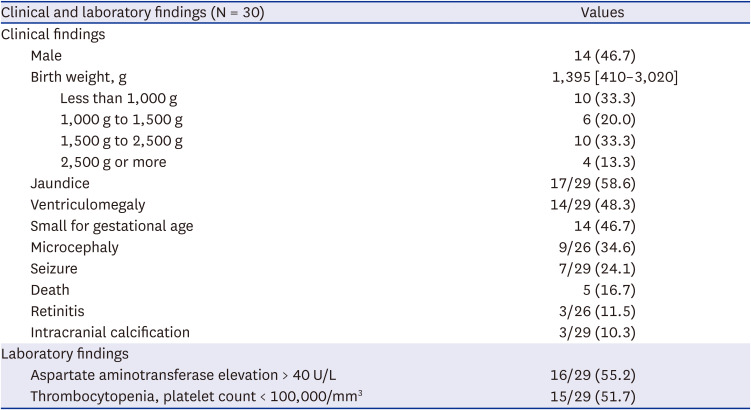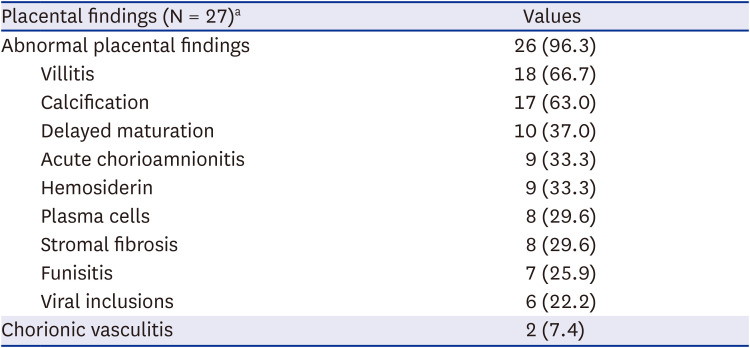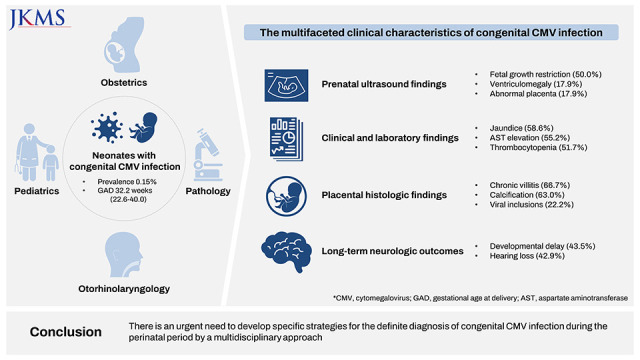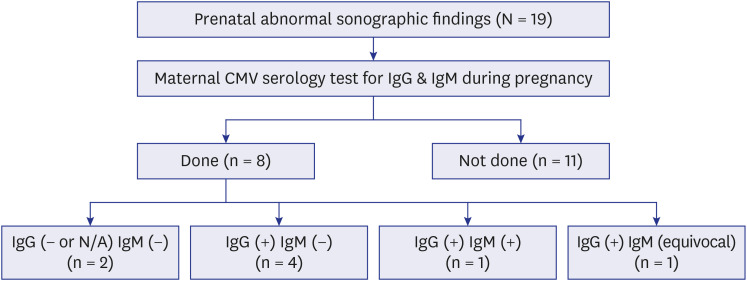1. Kenneson A, Cannon MJ. Review and meta-analysis of the epidemiology of congenital cytomegalovirus (CMV) infection. Rev Med Virol. 2007; 17(4):253–276. PMID:
17579921.
2. Leruez-Ville M, Ville Y. Fetal cytomegalovirus infection. Best Pract Res Clin Obstet Gynaecol. 2017; 38:97–107. PMID:
27923540.
3. Choi SR, Kim KR, Son S, Kim DS, Chang YS, Cho EY, et al. The prevalence of symptomatic congenital cytomegalovirus disease in Korea; a 15-year multicenter study and analysis of big data from National Health Insurance System. J Pediatric Infect Dis Soc. 2023; 12(2):104–108. PMID:
36399091.
4. Fowler KB, Boppana SB. Congenital cytomegalovirus infection. Semin Perinatol. 2018; 42(3):149–154. PMID:
29503048.
5. Dollard SC, Grosse SD, Ross DS. New estimates of the prevalence of neurological and sensory sequelae and mortality associated with congenital cytomegalovirus infection. Rev Med Virol. 2007; 17(5):355–363. PMID:
17542052.
6. Rawlinson WD, Boppana SB, Fowler KB, Kimberlin DW, Lazzarotto T, Alain S, et al. Congenital cytomegalovirus infection in pregnancy and the neonate: consensus recommendations for prevention, diagnosis, and therapy. Lancet Infect Dis. 2017; 17(6):e177–e188. PMID:
28291720.
7. Yinon Y, Farine D, Yudin MH. No. 240-cytomegalovirus infection in pregnancy. J Obstet Gynaecol Can. 2018; 40(2):e134–e141. PMID:
29447718.
8. de Vries JJ, van Zwet EW, Dekker FW, Kroes AC, Verkerk PH, Vossen AC. The apparent paradox of maternal seropositivity as a risk factor for congenital cytomegalovirus infection: a population-based prediction model. Rev Med Virol. 2013; 23(4):241–249. PMID:
23559569.
9. Choi R, Lee S, Lee SG, Lee EH. Seroprevalence of CMV IgG and IgM in Korean women of childbearing age. J Clin Lab Anal. 2021; 35(4):e23716. PMID:
33783845.
10. Choi SR, Kim KR, Kim DS, Kang JM, Kim SJ, Kim JM, et al. Changes in cytomegalovirus seroprevalence in Korea for 21 years: a single center study. Pediatr Infect Vaccine. 2018; 25(3):123–131.
11. Kim BJ, Han JJ, Shin SH, Kim HS, Yang HR, Choi EH, et al. Characterization of detailed audiological features of cytomegalovirus infection: a composite cohort study from groups with distinct demographics. BioMed Res Int. 2018; 2018:7087586. PMID:
30228987.
12. Kwak M, Yum MS, Yeh HR, Kim HJ, Ko TS. Brain magnetic resonance imaging findings of congenital cytomegalovirus infection as a prognostic factor for neurological outcome. Pediatr Neurol. 2018; 83:14–18. PMID:
29681488.
13. Grannum PA, Berkowitz RL, Hobbins JC. The ultrasonic changes in the maturing placenta and their relation to fetal pulmonic maturity. Am J Obstet Gynecol. 1979; 133(8):915–922. PMID:
434036.
14. Boppana SB, Ross SA, Fowler KB. Congenital cytomegalovirus infection: clinical outcome. Clin Infect Dis. 2013; 57(Suppl 4):S178–S181. PMID:
24257422.
15. Lim JS, Lim SW, Ahn JH, Song BS, Shim KS, Hwang IT. New Korean reference for birth weight by gestational age and sex: data from the Korean Statistical Information Service (2008–2012). Ann Pediatr Endocrinol Metab. 2014; 19(3):146–153. PMID:
25346919.
16. Uenaka M, Morizane M, Tanimura K, Deguchi M, Kanzawa M, Itoh T, et al. Histopathological analysis of placentas with congenital cytomegalovirus infection. Placenta. 2019; 75:62–67. PMID:
30712668.
17. Kimberlin DW, Jester PM, Sánchez PJ, Ahmed A, Arav-Boger R, Michaels MG, et al. Valganciclovir for symptomatic congenital cytomegalovirus disease. N Engl J Med. 2015; 372(10):933–943. PMID:
25738669.
18. Ross SA, Boppana SB. Congenital cytomegalovirus infection: outcome and diagnosis. Semin Pediatr Infect Dis. 2005; 16(1):44–49. PMID:
15685149.
19. Leruez-Ville M, Magny JF, Couderc S, Pichon C, Parodi M, Bussières L, et al. Risk factors for congenital cytomegalovirus infection following primary and nonprimary maternal infection: a prospective neonatal screening study using polymerase chain reaction in Saliva. Clin Infect Dis. 2017; 65(3):398–404. PMID:
28419213.
20. Yamada H, Tanimura K, Fukushima S, Fujioka K, Deguchi M, Sasagawa Y, et al. A cohort study of the universal neonatal urine screening for congenital cytomegalovirus infection. J Infect Chemother. 2020; 26(8):790–794. PMID:
32273174.
21. Hughes BL, Gyamfi-Bannerman C. Society for Maternal-Fetal Medicine (SMFM). Diagnosis and antenatal management of congenital cytomegalovirus infection. Am J Obstet Gynecol. 2016; 214(6):B5–11. PMID:
26902990.
22. Leruez-Ville M, Foulon I, Pass R, Ville Y. Cytomegalovirus infection during pregnancy: state of the science. Am J Obstet Gynecol. 2020; 223(3):330–349. PMID:
32105678.
23. Maltezou PG, Kourlaba G, Kourkouni E, Luck S, Blázquez-Gamero D, Ville Y, et al. Maternal type of CMV infection and sequelae in infants with congenital CMV: systematic review and meta-analysis. J Clin Virol. 2020; 129:104518. PMID:
32622333.
24. Lazzarotto T, Guerra B, Lanari M, Gabrielli L, Landini MP. New advances in the diagnosis of congenital cytomegalovirus infection. J Clin Virol. 2008; 41(3):192–197. PMID:
18054840.
25. Shahar-Nissan K, Pardo J, Peled O, Krause I, Bilavsky E, Wiznitzer A, et al. Valaciclovir to prevent vertical transmission of cytomegalovirus after maternal primary infection during pregnancy: a randomised, double-blind, placebo-controlled trial. Lancet. 2020; 396(10253):779–785. PMID:
32919517.
26. Jacquemard F, Yamamoto M, Costa JM, Romand S, Jaqz-Aigrain E, Dejean A, et al. Maternal administration of valaciclovir in symptomatic intrauterine cytomegalovirus infection. BJOG. 2007; 114(9):1113–1121. PMID:
17617198.
27. Leruez-Ville M, Ghout I, Bussières L, Stirnemann J, Magny JF, Couderc S, et al. In utero treatment of congenital cytomegalovirus infection with valacyclovir in a multicenter, open-label, phase II study. Am J Obstet Gynecol. 2016; 215(4):462.e1–462.10.
28. Lowance D, Neumayer HH, Legendre CM, Squifflet JP, Kovarik J, Brennan PJ, et al. Valacyclovir for the prevention of cytomegalovirus disease after renal transplantation. N Engl J Med. 1999; 340(19):1462–1470. PMID:
10320384.
29. Faure-Bardon V, Fourgeaud J, Stirnemann J, Leruez-Ville M, Ville Y. Secondary prevention of congenital cytomegalovirus infection with valacyclovir following maternal primary infection in early pregnancy. Ultrasound Obstet Gynecol. 2021; 58(4):576–581. PMID:
33998084.
30. Chung YS, Oh SH, Park SK. Results of a government-supported newborn hearing screening pilot project in the 17 cities and provinces from 2014 to 2018 in Korea. J Korean Med Sci. 2020; 35(31):e251. PMID:
32776720.
31. Korean Audiological Society, Korean Otologic Society. Korean Clinical Practice Guideline: Newborn Hearing Screening 2010. Seoul: ML Communications;2011. p. 1–80.
32. Park SK, Chang J, Im GJ, Ahn JH, Lee JH, Han KD, et al. Status of early hearing detection and intervention in South Korea: a nationwide population-based study of national infant health checkup. Sci Rep. 2020; 10(1):16838. PMID:
33033313.
33. Nicloux M, Peterman L, Parodi M, Magny JF. Outcome and management of newborns with congenital cytomegalovirus infection. Arch Pediatr. 2020; 27(3):160–165. PMID:
32127242.
34. Pesch MH, Kuboushek K, McKee MM, Thorne MC, Weinberg JB. Congenital cytomegalovirus infection. BMJ. 2021; 373(1212):n1212. PMID:
34083180.
35. Manicklal S, Emery VC, Lazzarotto T, Boppana SB, Gupta RK. The “silent” global burden of congenital cytomegalovirus. Clin Microbiol Rev. 2013; 26(1):86–102. PMID:
23297260.
36. Foulon I, Naessens A, Faron G, Foulon W, Jansen AC, Gordts F. Hearing thresholds in children with a congenital CMV infection: a prospective study. Int J Pediatr Otorhinolaryngol. 2012; 76(5):712–717. PMID:
22386305.
37. Dahle AJ, Fowler KB, Wright JD, Boppana SB, Britt WJ, Pass RF. Longitudinal investigation of hearing disorders in children with congenital cytomegalovirus. J Am Acad Audiol. 2000; 11(5):283–290. PMID:
10821506.
38. Kim JH, Roh KJ, Nam GS, Son EJ. Audiologic status of children with confirmed cytomegalovirus infection: a case series. J Korean Med Sci. 2020; 35(30):e244. PMID:
32743988.
39. Lee SY, Jeon HW, Ahn SY, Oh SH, Kim BJ, Choi BY. Significance of cytomegalovirus tests after three weeks of life in children with hearing loss. Int J Pediatr Otorhinolaryngol. 2023; 168:111555. PMID:
37075593.
40. Townsend CL, Forsgren M, Ahlfors K, Ivarsson SA, Tookey PA, Peckham CS. Long-term outcomes of congenital cytomegalovirus infection in Sweden and the United Kingdom. Clin Infect Dis. 2013; 56(9):1232–1239. PMID:
23334811.








 PDF
PDF Citation
Citation Print
Print





 XML Download
XML Download